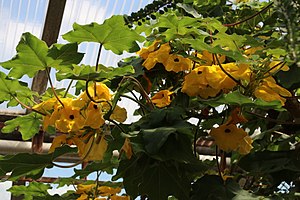Uncarina decaryi
| Uncarina decaryi | ||||||||||||
|---|---|---|---|---|---|---|---|---|---|---|---|---|

Uncarina decaryi |
||||||||||||
| Systematics | ||||||||||||
|
||||||||||||
| Scientific name | ||||||||||||
| Uncarina decaryi | ||||||||||||
| Humbert ex Ihlenf. |
Uncarina decaryi is a species of the genus Uncarina in the sesame family (Pedaliaceae).
description
Uncarina decaryi grows as a small tree with a sparsely branched crown and reaches a height of about 3 meters. The leaf blade , which is usually divided into 5 deep lobes and 2 smaller ones, is 12 inches long and 13 inches wide. The smaller lobes are at the base and are sometimes only indistinctly developed. The blade can also be pentagonal and indistinctly lobed or only with 3 lobes, of which the middle one is very large and the two outer ones are very small. The leaf margin is entire and on the green top of the leaf there are a few simple hairs and also only a few mucous glands provided with a short stalk. The underside of the leaf, with its many short-stalked mucous glands, appears strikingly grayish green. The mucous glands have a star-shaped head. Furthermore, there are few hairs with a reduced head on the underside.
The inflorescence consists of cymes with 3 to 6 individual flowers, sometimes only with one flower. They are usually not in dense clusters, but are repeatedly formed anew during the growing season. The yellow flowers are dark red in color in the throat. From the throat, red lines run to the base of the lower lobe. The cylindrical flower tube is about 5 centimeters long.
The fruit, squeezed at the side, is egg-shaped when viewed from the side and has a long, narrow and pointed beak . The fruits are 6 inches long and 3 inches wide. Two different forms of spines are formed on the fruit. The hook spines, up to 20 millimeters long, are about five in a row, and they do not go beyond the beak. The base of the spines is broadened. The numerous simple spines are up to 3 millimeters long. No false partitions are formed. The obovate seeds are 6 millimeters long and 4 millimeters wide. The wings are 0.5 millimeters in size.
Distribution and systematics
Uncarina decaryi is endemic in the south of Madagascar , in the south of the province of Toliara on sandy soils between gneiss rocks.
The species was first described in 1962 by Jean-Henri Humbert . However, this description turned out to be invalid in 2002, as two different herbarium specimens were given as the holotype . Hans-Dieter Ihlenfeldt validated the species in 2002.
literature
- H.-D. Ihlenfeldt: Uncarina . In: Urs Eggli (Hrsg.): Succulent lexicon. Volume 2: Dicotyledons (dicotyledons) , Ulmer, Stuttgart 2002, ISBN 3-8001-3915-4 , p. 381 f.
Web links
Individual evidence
- ↑ Adansonia Series 2, Volume 2, p. 210, 1962.
- ^ Hans-Dieter Ihlenfeldt: Validation of Uncarina decaryi (Pedaliaceae) . In: Cacti and other succulents . 53rd year (2002), issue 5, p. 124 f.